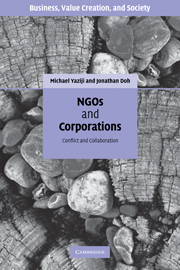Book contents
- Frontmatter
- Contents
- List of figures
- List of tables
- Preface
- Foreword
- Acknowledgments
- Part I Understanding NGOs
- Part II NGO advocacy campaigns
- Part III Corporate–NGO engagement
- 7 Corporate–NGO engagements: from conflict to collaboration
- 8 Globalization, multinationals and NGOs: the next wave
- Case illustration: conflict diamonds
- Case illustration: Unilever in Indonesia
- Case illustration: microfinance and poverty reduction
- Part IV The future of corporate–NGO relations
- Index
- References
Case illustration: microfinance and poverty reduction
Published online by Cambridge University Press: 13 January 2010
- Frontmatter
- Contents
- List of figures
- List of tables
- Preface
- Foreword
- Acknowledgments
- Part I Understanding NGOs
- Part II NGO advocacy campaigns
- Part III Corporate–NGO engagement
- 7 Corporate–NGO engagements: from conflict to collaboration
- 8 Globalization, multinationals and NGOs: the next wave
- Case illustration: conflict diamonds
- Case illustration: Unilever in Indonesia
- Case illustration: microfinance and poverty reduction
- Part IV The future of corporate–NGO relations
- Index
- References
Summary
Financial institutions have provided low-income individuals with small loans for decades. The explosion of microfinance institutions (MFIs) during this period constitutes a significant shift in the international development community. Microfinance initiatives have been implemented as a way to curb poverty, promote community-based development and make a profit. In some instances, the objectives are mutually exclusive, and the cost of making a profit rests on the poverty-stricken in the form of high interest rates. These rates, for the most part, must be high in order for the loaning institution to cover the transfer costs incurred when making many small loans as opposed to a few large loans. Certain poverty-stricken areas could also pose a significant risk to the lending company, deterring them from erecting a branch and increasing costs of loan delivery. Overall, these costs could contribute to the dynamic of the rich getting richer as the poor dive deeper into poverty. This does not seem to be a universal trend, as the microfinance movement received worldwide recognition when Muhammad Yunis, considered the founder of microfinance, was awarded the Nobel Peace Prize in 2006.
Microfinance can attribute its success in the developing world to the nonexistent, weak or exclusionary financial markets. Formal credit systems have a short-sighted reach, providing access to only 1–2 percent of the developed world population. This leaves room for opportunities in the microfinance sector, as a majority of the loans are paid back due to a high return on investment in microenterprises.
- Type
- Chapter
- Information
- NGOs and CorporationsConflict and Collaboration, pp. 169 - 172Publisher: Cambridge University PressPrint publication year: 2009



